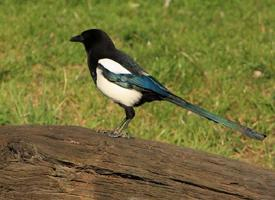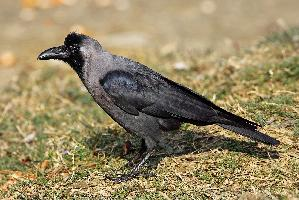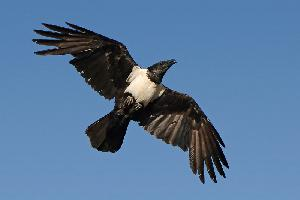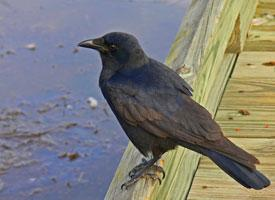
Poids et mesures
| Longueur | de 40 à 51 cm |
|---|---|
| Poids | de 150 à 240 g |
| Envergure des ailes | de 52 à 60 cm |
Description de l'animal
The Eurasian magpie (Pica pica) is a striking and intelligent bird species belonging to the crow family, Corvidae, known for its distinctive appearance and complex behaviors. With its widespread presence across Europe, Asia, and parts of North Africa, this bird has captured human imagination and folklore for centuries.Physical Description:
The Eurasian magpie is a medium-sized bird, typically measuring between 44 to 46 centimeters in length, with a wingspan ranging from 52 to 62 centimeters. One of the most striking features of the magpie is its plumage. The bird boasts a glossy black and white coloration, with the black areas showing iridescent shades of blue, green, and purple upon closer inspection, especially under sunlight. The belly, flanks, and shoulder patches are predominantly white, creating a stark contrast with the darker hues of its wings and tail. The tail is long and wedge-shaped, contributing significantly to the bird's length and is one of its most distinctive features. The magpie has a robust black bill, strong legs, and relatively small, rounded wings compared to its body size.
Habitat and Distribution:
Eurasian magpies are highly adaptable birds, inhabiting a wide range of environments including woodlands, farmlands, and even urban areas. Their ability to thrive in diverse habitats has allowed them to occupy a vast geographical range. They prefer areas where trees are available for nesting but are equally comfortable foraging in open spaces.
Behavior and Diet:
Eurasian magpies are known for their intelligence, ranking among the most intelligent of birds. They exhibit complex social behaviors and have been observed using tools, a rare trait in the avian world. Magpies are omnivorous, feeding on a varied diet that includes insects, small mammals, seeds, fruits, and carrion. They are also known to store food in various locations for later consumption, showcasing their problem-solving skills and memory.
Magpies are monogamous, forming long-lasting pair bonds. Their nests are large, dome-shaped structures built in trees, consisting of twigs and lined with mud and soft materials. The female lays between 5 to 8 eggs, which she incubates while being fed by the male. Both parents take part in rearing the young.
Communication and Social Structure:
Eurasian magpies have a complex system of communication that includes a variety of vocalizations used to express alarm, attract mates, or communicate with their group. They are social birds, often seen in pairs or small family groups, although larger gatherings may occur in areas with abundant food sources.
Cultural Significance:
Throughout history, the Eurasian magpie has been a subject of superstition and folklore in many cultures, often associated with luck, both good and bad. Its striking appearance and curious nature have made it a prominent figure in stories and myths across its range.
Conservation Status:
Currently, the Eurasian magie is listed as Least Concern by the International Union for Conservation of Nature (IUCN), reflecting its wide distribution and stable population numbers. However, like many species, it faces threats from habitat destruction and changes in agricultural practices.
In conclusion, the Eurasian magpie is a fascinating bird, notable for its intelligence, distinctive appearance, and adaptability. Its presence across a vast geographic area and its interactions with human culture make it a prominent feature of the avian world.
Animaux similaires
Nouvelles photos d'animaux
Top 10 des animaux
- Dolphin gull (Leucophaeus scoresbii)
- Diana monkey (Cercopithecus diana)
- Moustached guenon (Cercopithecus cephus)
- Galápagos tortoise (Geochelone nigra complex)
- Japanese macaque (Macaca fuscata)
- Stone loach (Barbatula barbatula)
- Russian tortoise (Testudo horsfieldii)
- Greek tortoise (Testudo graeca)
- Common flying dragon (Draco volans)
- Vendace (Coregonus albula)


